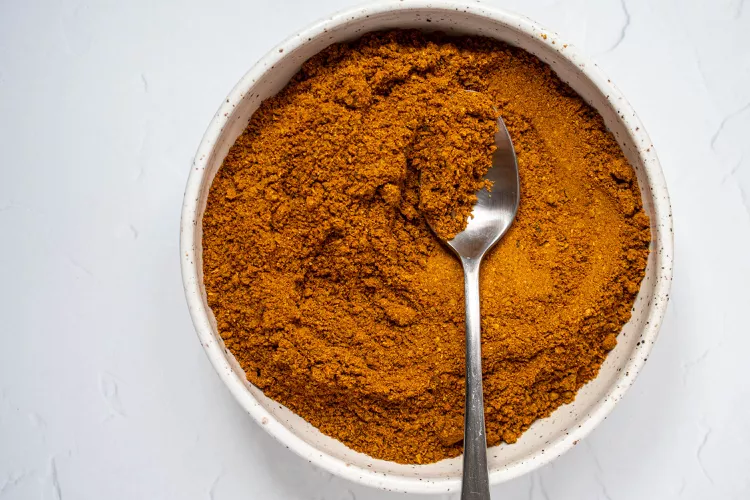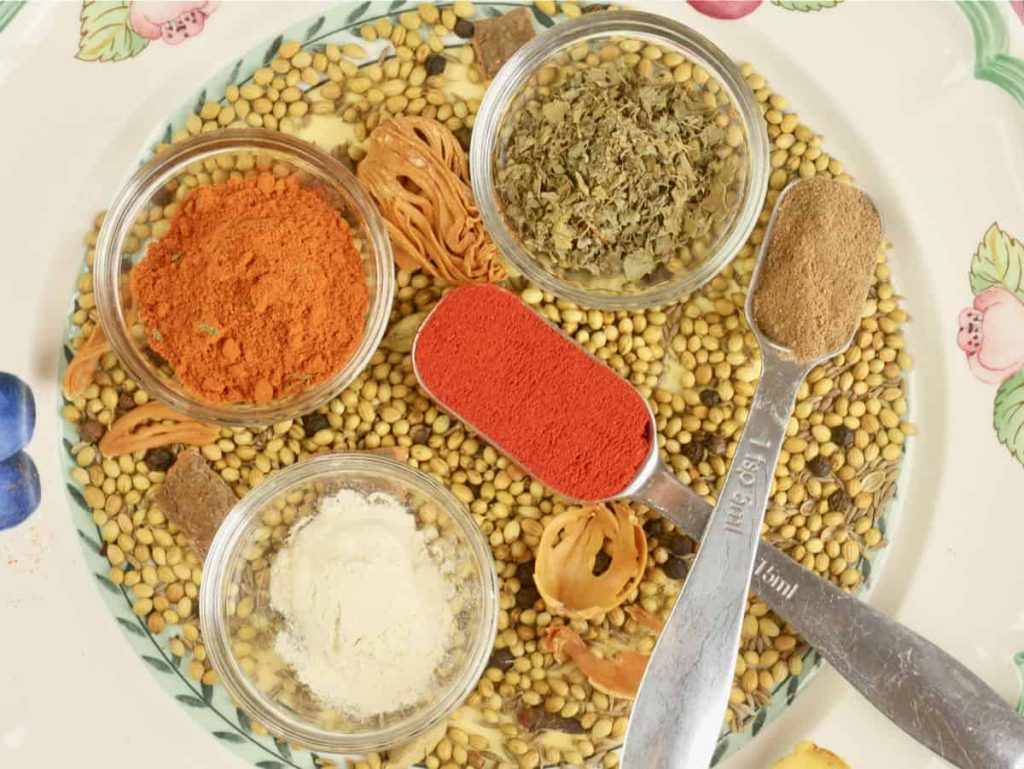Introduction
Tandoori masala, an aromatic and flavorful spice blend, is central to many traditional Indian dishes, particularly those prepared in a tandoor, a cylindrical clay oven. With its deep red color and complex flavor profile, this spice mix is responsible for the distinctive taste and vibrant appearance of tandoori dishes like tandoori chicken, paneer tikka, and tandoori prawns. This article will explore tandoori masala, its ingredients, a detailed recipe for making it at home, and the various culinary uses of this versatile spice blend.
Tandoori masala is a blend of spices traditionally used in Indian cuisine, especially for marinating and flavoring meats and vegetables cooked in a tandoor. The word “tandoori” is derived from “tandoor,” an oven originating in the Indian subcontinent. This masala is known for its robust, smoky flavor and is typically bright red or orange, owing to the addition of red chili powder and sometimes food coloring.
The masala’s flavor is a harmonious balance of earthy, spicy, tangy, and smoky notes from various spices such as cumin, coriander, ginger, garlic, and cloves. Tandoori masala is used in marinades and cooking, adding depth and complexity to dishes.
Tandoori Masala Recipe
Creating tandoori masala at home allows you to alter the mixture to your preferences. Here is a traditional recipe for making tandoori masala:
Ingredients:
- Cumin Seeds – 2 tablespoons
- Coriander Seeds – 2 tablespoons
- Black Peppercorns – 1 tablespoon
- Cardamom Pods – 1 tablespoon
- Cloves – 1 teaspoon
- Cinnamon Stick – 1-inch piece
- Nutmeg – 1/4 teaspoon, grated
- Mace – 1/4 teaspoon
- Dry Ginger Powder – 1 tablespoon
- Garlic Powder – 1 tablespoon
- Turmeric Powder – 1 tablespoon
- Red Chili Powder – 2 tablespoons
- Paprika – 2 tablespoons (for color)
- Salt – 1 tablespoon
Instructions:
Toast Whole Spices: On a dry pan, toast the cumin, coriander, mustard seeds, black peppercorns, cardamom pods, cloves, and cinnamon sticks on medium heat until fragrant, about 2-3 minutes. Stir frequently and toast until fragrant.
Cool and Grind: Pound the spices between a mortar and pestle or other fine-grinding tool spice grinder once the spices have cooled.

Mix with Ground Spices: Combine the freshly ground spices with the dry ginger powder, garlic powder, turmeric powder, red chili powder, paprika, grated nutmeg, mace, and salt. Thoroughly mix to guarantee that all of the spices are distributed evenly.
Store: Transfer the tandoori masala to a sealed container and store it in a cool, dark place. It will stay fresh for up to six months.
Because it doesn’t contain artificial coloring or preservatives, this homemade tandoori masala is a healthier alternative to store-bought varieties.
Similarly, Easy And Healthy Recipes With Garam Masala
Health Benefits of Tandoori Masala
Tandoori Masala, a popular spice blend used in Indian cuisine, is known for its vibrant flavor and aroma. It is made from a combination of spices, including cumin, Coriander, turmeric, paprika, garlic powder, ginger, and various other ingredients, depending on the recipe. Beyond its culinary use, Tandoori Masala offers several health benefits:
Rich in Antioxidants
- Turmeric: It contains curcumin, a powerful antioxidant and anti-inflammatory compound.
- Paprika: Provides vitamin C and other antioxidants that help protect the body against free radical damage.
Anti-inflammatory Properties
- Ginger and Garlic: Both have strong anti-inflammatory qualities, which can help lower inflammation and relieve ailments like arthritis.
- Turmeric: Its curcumin component is also known for its anti-inflammatory effects.
Digestive Health
- Cumin and Coriander: Aid in digestion and can help alleviate bloating and gas.
- Ginger: Traditionally used to ease stomach discomfort and enhance digestive function.
Boosts Immune System
- Garlic: Contains allicin, which has been shown to boost the immune system.
- Turmeric: Enhances the body’s immune response.
Heart Health
- Cumin and Coriander: It May help lower cholesterol levels and improve heart health.
- Garlic: Known to reduce blood pressure and improve cholesterol levels.
Weight Management
- Cumin and cayenne pepper can boost metabolism and help manage weight by increasing calorie burning and reducing appetite.
Tandoori Masala Powder Uses
Tandoori masala powder is incredibly versatile and can be used in various culinary applications. Here are some popular uses:
Marinades: Tandoori masala is most commonly used in marinades for meats, seafood, and vegetables. Mixing the masala with yogurt, lemon juice, and some oil creates a rich marinade that tenderizes the protein and infuses it with flavor. For instance, tandoori chicken is made by marinating chicken pieces in this mixture before cooking them in a tandoor or oven.
Grill and BBQ: The spice blend is perfect for grilling or barbecuing. Apply it directly to meats, vegetables, and oil, and grill them perfectly. The high heat caramelizes the spices, creating a smoky, flavorful crust.
Curries: Add tandoori masala to curries to impart a rich, smoky flavor. It can be used in tomato-based gravies, creamy sauces, or even lentil dishes to elevate their taste.
Roasted Vegetables: Toss vegetables like potatoes, cauliflower, and bell peppers with tandoori masala and some oil before roasting them in the oven. The result is a vibrant, flavorful side dish.
Rice and Biryani: Enhance your rice dishes by adding a spoonful of tandoori masala. It works wonderfully in biryanis or simple fried rice, giving the dish a rich color and depth of flavor.
Stews and Soups: To add complexity, incorporate tandoori masala into soups and stews. It is also helpful in lentil soups and vegetable stews.
Snacks and Appetizers: Season snacks and appetizers like chickpeas, nuts, or popcorn with tandoori masala. It provides a unique and spicy twist.
Sauces and Dips: Mix tandoori masala with yogurt, sour cream, or mayonnaise to create flavorful sauces and dips. These can be served with kebabs, grilled meats, or as a spread for sandwiches.

Experimenting with tandoori masala in various dishes might assist you in finding novel and fascinating methods to enjoy its robust flavors.
Conclusion
Tandoori masala is more than just a spice blend; it celebrates Indian culinary tradition and heritage. Its unique combination of spices brings a depth of flavor and vibrant color to various dishes, making it a staple in many kitchens worldwide. Whether marinating meats, grilling vegetables, or adding a kick to your soups and stews, tandoori masala can elevate your cooking.
Making tandoori masala at home is a rewarding experience that allows you to control the quality and balance of flavors in your blend. With a well-stocked spice rack and patience, you can create a homemade tandoori masala that rivals any store-bought version.
Incorporating tandoori masala into your culinary repertoire enhances the taste of your dishes and connects you with a rich tradition of Indian cooking. Its versatility ensures that you will find countless ways to use this spice blend, bringing warmth, color, and flavor to your meals. Consequently, whether you are an experienced chef or a culinary novice, tandoori masala is a must-have ingredient that promises to delight your taste buds and impress your guests.
Read More: Thyme Seeds: Uses, Guide and Benefits

